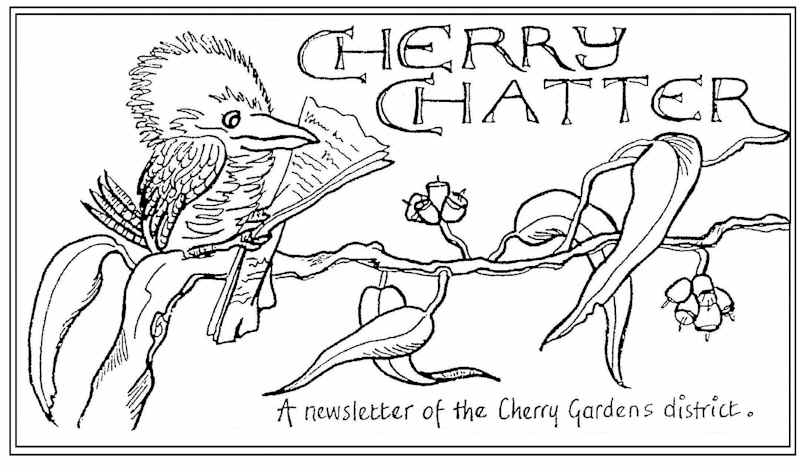History Corner: Ironbank, Mt. Lofty Ranges SA
Reminiscences of lronbank and its people of long ago, as remembered and written by Mr. Edward Palmrose, a descendant of Elizabeth Coat and Victor Palmrose.
Ironbank - Mt. Lofty Ranges, S.A.
The first road was cut from Upper Sturt Road (where the post office and store are today), down a steep gully to the Sturt River below, a distance of ¾ of a mile, and thereon to Ironbank was a dirt road. All produce for Adelaide and nearby shops grown by the early settlers, was hauled by bullocks up this steep incline, then transferred to horse drawn vehicles for delivery. Fodder, food, tools and implements on return trips were reloaded to the bullock trolleys and by placing gum and wattle poles through wheel spokes to hold the load, the trolleys made their way down to the Sturt River. As more settlers came, a new road was cut (now known as Pole Rd.). A Scottish man got the contract and on completion, received the same daily amount as his men.
Many fine families of hard working folk, growing such crops of apples, pears, plums, peaches, nectarines, lemons, strawberries, red currants , raspberries, all types of vegetables-bee keeping, pigs, cows, and particularly horses, for transporting goods, and their only form of commuting was the spring cart or buggy. No radios, power or telephones, no coal or coke, but plenty of wood, the huge fireplaces taking logs three or four feet long.
Most of the old homes were built of stone, raised or carted from their own properties, some consisted of wattle and daub (wattle sticks with clay and lime between). Cellars kept cream and butter etc. cool, so did any unused fireplaces. Legs of smoked hams would hang from kitchen ceilings.
As the crops came so did the birds and vermin-rabbits, hares, foxes, possoms, field mice, rats and snakes-brown, copper, black and the diamond, and when your domesticated cat played with a small snake, it was certain death. A local man in search of game, came face to face with a brown bear near the Sturt River. He sought help from other men and captured it with the aid of large chaff bags. The bear was four feet high. Later it was claimed by a travelling circus from which it had escaped.
Large and small holdings were taken over in this picturesque Ironbank hills area, and some of those names ("that really rings a bell") are - Wescombe, Evans, Slater, Coat, Pole - (two miles of road so named) and Coat Road. Now to the old church at Ironbank. It was the early school also. The heart of Ironbank centred around the Morgans' and Poles'. All these old names are steeped in memory of those times.
Victor Palmrose married the only daughter of John and Elizabeth Coat in approximately 1882. He made and erected the pulpit in the church. When their first-born baby was taken ill he walked to the nearest doctor at Mitcham for help, but the baby died on the way home.
Sunday was always a very religious day, one would see horses (many bare-back) tied to trees, spring carts, traps and buggies, while other folk walked long distances to worship. Dogs seemed to scent down their owners or meet at the church also, and when too many congregate - a fight begins. On one occasion, a stick was used to separate them and soon this started the owners (who surmised their dogs were being punished harshly) to jostle each other about.
Entertainment and pastimes
There always seemed plenty to do such as-pipe records (this is an Edison record) on the many phonographs-piano sing songs of hymns and tunes of that period-concertinas and accordeon music-games of all kinds-outside sports-playing cards-draughts-dice games-toys for the children-home educational books and seeing pictures in a kaleidoscope.
The most common items for the ladies and girls was the sewing machine, also the painting easel, box of knitting needles etc. Perhaps the most interesting for quiet viewing was the "Magic Lantern" -placed on a table with a good kerosene lamp close to it and a white sheet attached to the wall would, by placing celluloid picture cards in the slot , give an assortment of interesting items, done with mirrors and magnifying glasses. As the crops became more plentiful and more pickers were required, tents would be erected for their quarters. One man liked the area so much he cut a room in the hillside and lived in Wescombe's gully and was known as Mr. Crocker. The first easy irrigation was done by John Coat and Victor Palmrose. Moving stone and clay, they formed a long channel, after taking levels of the hillside to a large piece of workable land below. Then the day came to try it out and successful it was. They picked out the last rocks and earth towards an underground spring. Tons of vegetables came from that track of land.
